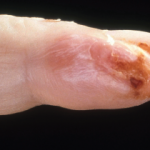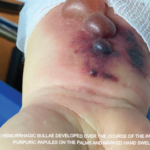The clinical picture is usually sufficient to make the diagnosis of PPD, and most cases do not require laboratory investigations. In select cases, a biopsy may be warranted to rule out vasculitis or other clinical mimickers, such as in rare cases, cutaneous T-cell lymphoma. There is some controversy as to whether there is an association between PPD and cutaneous T-cell lymphoma (CTCL); however, common belief is that CTCL and PPD are distinct entities that can, in rare cases, bear clinical resemblance.7
Though benign, PPD can be pruritic and distressing, and adequate treatment can be difficult. Medium to high potency topical corticosteroids are generally attempted as first-line therapies when treatment is warranted. Occasionally, oral antihistamines may help relieve pruritus. If lesions on the lower extremity are associated with venous stasis, compression stockings may be of benefit. Additional off-label therapies include phototherapy, pentoxyphylline, griseofulvin, and cyclosporine, which may be helpful in select cases. No single treatment is uniformly effective and recurrences often occur. Spontaneous remission over months to years is not uncommon.
Table 1
Clinical and histologic features of PPD
| Clinical features | Unique histologic features | |
| Schamberg’s purpura |
Copper-brown macules with “cayenne pepper” petechiae | |
| Gougerot-Blum syndrome | Small coalescing violaceous papules | Lichenoid band (dense band-like lymphocytic infiltrate in the superficial dermis) |
| Lichen aureus | Sudden onset of golden-brown macules and papules | Lichenoid band (dense band-like lymphocytic infiltrate in the superficial dermis) |
| Ducas and Kapetanakis pigmented purpura | Eczematous scaly patches with petechiae | Spongiosis (edema of epidermis) |
| Purpura annularis telangiectodes | Annular blue–red scaly patches with petechiae |
Dr. Femia completed a fellowship in dermatology–rheumatology at Brigham and Women’s Hospital in Boston, MA, and is now an assistant professor in the department of dermatology at New York University. She is a diplomat of the American Board of Dermatology.
Dr. Merola is an instructor in the department of dermatology at Harvard Medical School and an instructor in the department of medicine, division of rheumatology at Brigham and Women’s Hospital, both in Boston. He is the assistant program director for the combined medicine–dermatology training program and a diplomat of the American Board of Dermatology and the American Board of Internal Medicine.
References
- Zaballos P, Puig S, Malvehy J. Dermoscopy of pigmented purpuric dermatoses (Lichen Aureus): A useful tool for clinical diagnosis. Arch Derm. 2004;140:1290-1291.
- Torrelo A, Requena C, Mediero IG, Zambrano A. Schamberg’s purpura in children: A review of 13 cases. JAAD. 2003;48:31-33.
- Lee HW, Lee DK, Chang SE, et al. Segmental lichen aureus: Combination therapy with pentoxifylline and prostacycline. J Eur Acad Dermatol Venereol. 2006;20:1378-1380.
- Tristani-Firouzi P, Meadows KP, Vanderhooft S. Pigmented purpuric eruptions of childhood: A series of cases and review of literature. Pediatr Dermatol. 2001;18:299-304.
- Sardana K, Sarkar R, Sehgal VN. Pigmented purpuric dermatoses: An overview. Int J Dermatol. 2004;43:482-488.
- Aiba S, Tagami H. Immuno-histologic studies in Schambergs’ disease: Evidence for cellular immune reaction in lesional skin. Arch Dermatol. 1988;124:1058-1062.
- Magro CM, Schaefer JT, Crowson AN, Jingwei L, Morrison C. Pigmented purpuric dermatosis: Classification by phenotypic and molecular profiles. Am J Clin Pathol. 2007;128:218-229.
- Kavala M, Zindanci I, Sudogan S, et al. Mycosis fungoides presenting as hypopigmented and pigmented purpura-like lesions: Coexistence of two clinical variants. Eur J Dermatol. 2011;21:272-273.


